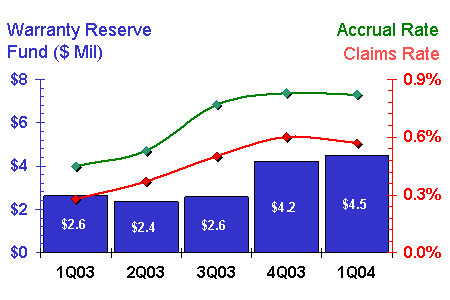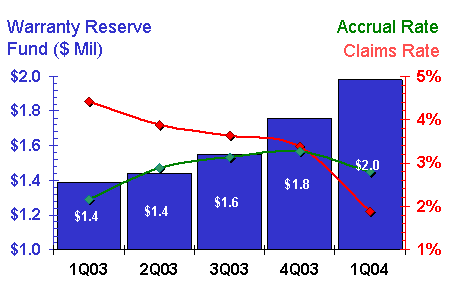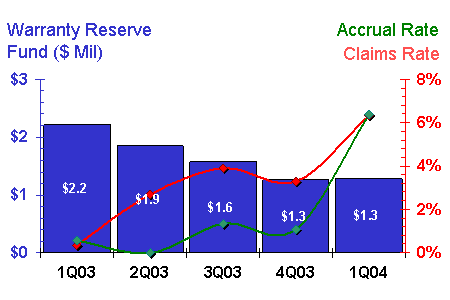May 25, 2004 |
ISSN 1550-9214 |
Warranty Measures:Matching warranty claims and accruals to reserves has always been a balancing act. Now it must be done in public, making it harder to conceal raids on the reserve fund or spikes in claims. But it's also easier to see how a company's quality improvements and claims reductions can translate to bottom-line gains by reducing the need for reserves.Although it remains doubtful that current levels of accounting standards will ever allow an accurate comparison of one company's warranty costs to another's, it is already becoming possible to compare one company against itself. Thanks to the existence of fifteen months of data on some 750 manufacturers' warranty claims and accruals, the ups and downs of each company's warranty reserve fund can reveal insights into not only whether product quality is increasing, but also whether chief financial officers are keeping a close watch over the money they set aside to pay claims. While waiting for the remaining few dozen manufacturers to file their latest Form 10-Q or 10-K statements with the U.S. Securities and Exchange Commission, Warranty Week took a look at data stretching back to January 1, 2003 to see not only whether the size of warranty reserve funds was increasing or decreasing, but also whether claims and accrual rates were moving in unison or in opposition with the fund balance. For any given company, there are four possibilities:
One could argue that at least several more permutations exist where either reserves or claims rates (or both) remain steady, possibly because sales are also flat or because product quality has remained constant. In practice, though, very few companies seem to have been able to keep their reserve fund balance unchanged for the past five quarters, and fewer still can say that their claims rates have remained steady. What turns out to be a bit more common is when claims, accruals, and reserves each have a mind of their own, meandering from quarter to quarter with no discernable trend in view. Warranty Week took the universe of 750 warranty-reporting U.S. manufacturers and divided it into four groups, as defined above. But first, we had to make some eliminations. First to go were all the manufacturers who have never held $1 million or more in their reserve funds. This was done because fluctuations seem to be all the more extreme at the smallest end of the scale. Conversely, the few companies that have ever held more than $1 billion in their reserve funds seem to turn in rather level performances, both in terms of fund balances and in claims/accrual rates as a percentage of sales. Next to go were all the companies that have only partially reported upon their warranty accounting practices during the past five quarters. One favorite accounting ploy seems to be the disclosure of just the beginning and ending balances in the warranty reserve, which invites the reader to mistake the increase or decrease in the fund's size for the cost of warranty. For instance, let's say a company begins a quarter with $10 million in its reserve fund, spends $4 million on claims, and accrues $5 million for newly-issued warranties. Its ending balance would be $11 million, and it might even report in its cash flow statement a $1 million increase in reserves, which some might mistake for the amount of claims. In fact, claims were four times higher, and accruals were five times higher. The Financial Accounting Standards Board, in FASB Interpretation No. 45, mandates the full disclosure of aggregate claims and accruals in addition to beginning and ending balances, in tabular form. Another favorite ploy is to make the disclosure of warranty information an annual event. FASB Interpretation No. 45 mandates that a warranty table be included in all annual and interim financial statements, but evidently some companies have not yet bothered to read that paragraph. According to the SEC, companies not in compliance with all FASB accounting standards cannot consider themselves to be following GAAP -- Generally Accepted Accounting Principles. After making all these subtractions for size and for partial non-compliance, we were still left with 480 companies. But there was one more exclusion to be made. Of the 480 companies, 54 were what could be called "trendless," in that reserves increased then decreased, or claims rates fell then rose, resulting in graphs that looked something akin to a sine wave in a valley. One suspects that as more data becomes available over time, more manufacturers will fit into more than one of the four groups during different periods. For instance, in 2003 reserves and claims might decline in parallel, but in 2004 they might move into opposition to each other, and in 2005 they might both begin to ascend. Surprisingly, however, within these five quarters of data, only 11% of large and medium-sized manufacturers fell into this "trendless" category. The Big PictureThey say a picture is worth a thousand words, so to cut down on the explanation, let's take a look at a company that has turned in an incredible performance during the past 15 months. Computer manufacturer Gateway Inc. may not be able to declare a profit, but it cut its warranty costs as a percentage of sales from the 6% levels seen in early 2003 to 5% by midyear and under 3% by early this year. At the same time, what initially looked like a precarious drainage of its warranty reserve fund has turned out to be more of a year-long exercise in rightsizing. Warranty accruals have closely tracked claims, making the succession of warranty reserve fund balance readings look something like a staircase. Take a look: Figure 1
Gateway Inc. Warranty Reserves, Claims & Accruals, First Quarter 2003 to First Quarter 2004  Source: Warranty Week from SEC data Warranty reserves follow the left-hand axis and are denominated in $ millions, while claims and accrual rates follow the right-hand axis and are expressed in percentages of quarterly product sales. All are measured at the end of each quarter. What this graph means is that Gateway's reserves, claims, and accruals declined more or less in parallel, which would make them the poster boy for group 3 above. Warranty Week found that 108 companies, or roughly 25% of the sample size, fell into this category. Three essential trends are highlighted by this chart. First, the downward slope of the red line shows that warranty claims as a percentage of product sales are on the decline. Second, the parallel track of the green line shows that the company's financial forecasters are measuring the same trend, and are adjusting their expectations for future claims downwards as well. In other words, they're spending less, and they're realizing it, so they're putting less aside for the future. And third, they're doing so in a way that gradually reduces the size of their reserve fund, moving no-longer-needed funds to the bottom line. Sounds like just another day at the office? After all, isn't this how all companies are supposed to behave? If only we could provide all 480 charts in a single newsletter. Besides the sine waves in a valley, there are numerous companies that seem to manage their warranty accounts like ... well, let's be kind and say like they think nobody's paying attention. In fact, we really had to dig to find representatives of the other three groups with trend lines as clear as Gateway's. Oh, we should make one other point. To make sure that the trends were as noticeable as possible in these graphs, we looked only at companies for which the balance in their reserve funds rose or fell by more than 30% from March 31, 2003 to the same date in 2004. You would think that would overly restrict our field of view, but incredibly it left us with 143 graphs to choose among. Had we not excluded companies with less than $1 million in their reserves, the list of candidates would have been almost twice as long. The equal and opposite of Gateway -- almost a mirror image, really -- would be the Emulex Corp., makers of data communications and storage gear. Emulex and some 111 other companies fell into group 1, where reserves, claims, and accruals are all increasing over time. In the company's defense, however, claims are increasing from a very low level to a merely low level, so there's hardly a manufacturing crisis at hand. In early 2003 the firm's claims rate was under 0.3% but it doubled to 0.6% by early this year. Even in the telecom/datacom industry, those are low rates. Figure 2
Emulex Corp. Warranty Reserves, Claims & Accruals, First Quarter 2003 to First Quarter 2004  Source: Warranty Week from SEC data Notice also that in this graph, because the green line is above the red line, accrual rates exceed claims rates -- exactly the opposite of Gateway's example. The obvious effect is that because more was added than subtracted, the fund balance grew over time. That the two rates moved so closely in parallel shows that management was on top of the situation, doing exactly what the boilerplate phrases in most quarterly statements say they do: assessing the adequacy of its recorded warranty liabilities and adjusting the amounts as necessary to match actual results. Who's Minding the Store?The next example shows that this practice is far from universal. For while 15% of manufacturers fell into the up-and-up category and 26% fell into the down-and-down category, an unlikely 32% fell into category 2, where claims and accruals are falling yet reserves continue to increase. There could be numerous reasons for this combination of trends, but undoubtedly one big reason is that nobody's paying attention to warranty. Claims are falling, but instead of passing on the savings to investors through either decreased accruals or downward changes of estimate, the companies in category 2 are allowing their reserves to build up. Other factors are at work, of course. Most importantly, product sales could be on an upswing, meaning that reserves need to be larger to pay future claims. But in general, when the red line and the green line aren't moving in parallel, somebody in the accounting department isn't paying attention. In fact, at the very largest manufacturers -- companies like General Motors, Ford, and Hewlett-Packard -- the lines frequently merge and overlap, and they rarely show much of a sustained rise or fall over time. This is the result of them having 50, 100, or even more people paying very close attention to their warranty accounts. There also is the reality that most companies find a lag between claims and accruals. In other words, products sold in late 2003 won't begin showing up as claims until early 2004. Assuming that funds are accrued as products are sold, the money won't be needed to pay claims for 30, 60, or even 90 days or more. The reverse is also true. Ford and GM adjusted their reserves in mid-2003 based on the lower claims rates they saw for cars they sold in 2001 and 2002. Claims fell first, followed by accruals, adjusted by changes in estimate. Cybex International Inc. makes exercise equipment. In 2003 the company reported just under $2.9 million in warranty claims and $2.8 million in accruals, resulting in rates of 3.4% and 3.3% of sales, respectively. That sounds like a close match, but take a look at the underlying trends in the graph below. Figure 3
Cybex International Inc. Warranty Reserves, Claims & Accruals, First Quarter 2003 to First Quarter 2004  Source: Warranty Week from SEC data All year, warranty accrual rates were creeping upwards while claims rates were falling. By early 2004, claims rates were well below accruals. Meanwhile, over five quarters, warranty reserves grew by more than 42%. Put another way, the company at the beginning of 2003 had enough on hand to pay five months of claims out of the reserves they had on hand. By early 2004, they had more than 13 months' worth. While the company's claims and accrual rates were nearly the same at the end of 2003, this turns out to be merely the point at which they intersected. Of the 428 companies in the sample, 135 or 32% fell into this category, where claims were moving in one direction while reserves were moving in the other. Fortunately, in each of these cases, a company can easily adjust their accounts through a downwards change of estimate, passing on to investors the funds that are no longer needed as a cushion to pay claims. More properly, the cushion is becoming too thick, given current rates of claims. Depleting ReservesFinally, there is category 4, into which thankfully only 17% of companies in the sample fell. This is the category in which claims rates are increasing, which itself is a troublesome trend. However, reserves are falling, which means a given company's capacity to pay claims is probably decreasing as well. Last year, there was a company that saw claims rise to more than 30% of product sales. As this happened, the company drained its reserves because accruals did not keep pace. It was no surprise to find during this go-round that the company no longer needs to file Form 10-Q statements with the SEC, because it's now in liquidation. That is not the inevitable end for the 71 companies found to be in this worrisome category. However, when profits are down and costs have been cut to the bone, the lure of the cash in the warranty reserve may prove irresistible to some chief financial officers. Why not under-accrue and run down the reserves a bit? Nobody will notice. After all, who pays attention to something as obscure as warranty accounting? Glenayre Technologies Inc. is a manufacturer of messaging systems for telephone networks, primarily wireless carriers. From the first quarter of 2003 to 2004, product sales fell from $9.4 to $5.8 million. the cost of sale grew from $3.7 to $5.9 million. But because service revenue grew and the cost of service fell, the company's net loss for the quarter shrank from $6.3 in 2003 to $5.8 million in 2004. It's a very good company with well-respected products, and in fact your editor in a previous life used to write about them all the time in an electronic messaging newsletter. It's just that they don't seem to be on top of their warranty game any longer. Take a look at the following chart, and see if you don't agree. Figure 4
Glenayre Technologies Inc. Warranty Reserves, Claims & Accruals, First Quarter 2003 to First Quarter 2004  Source: Warranty Week from SEC data The company started off 2003 well enough, reporting only $33,000 in warranty claims on $9.4 million in product sales. That translates into a barely registering 0.35% claims rate. In the first quarter of 2004, claims had risen to $370,000 -- an eleven-fold increase. But because of the concurrent drop in product sales, the claims rate was 18 times higher than a year before. Meanwhile, because of inadequate accruals, the company's reserves declined from $2.2 to $1.3 million, a 42% drop. In terms of capacity, Glenayre went from having enough to pay 200 months of claims in March 2003 to having only 10 months' worth in March 2004. That hardly puts the company in a precarious position, but it does illustrate how fast conditions can change. We're not going to name the other 70 companies in the same group as Glenayre. Perhaps it's not fair to even name them. But a public company is a public figure, and its accounts are posted in public for all to see. It may not be fair, but at least it's accurate. Financial analysts used to guess a company's claims rates plus or minus one percent, and they felt blessed to know the size of a company's reserve fund with any precision. Now, thanks to FASB FIN 45 disclosures, detailed and exact charting is possible. While a few companies such as Dell Inc. are now trying to re-obscure their product warranty accounts by combining them with other balances, most companies are moving in the opposite direction towards full disclosure. This will make it more difficult to "manage" earnings by manipulating accrued expenses -- banking the excess during good times and borrowing it back during the slow quarters. It also will make it easier for financial analysts in the future to understand what's normal for a given company and for a given industry, and to measure deviations from those norms on a quarterly basis. | |||||||
|







